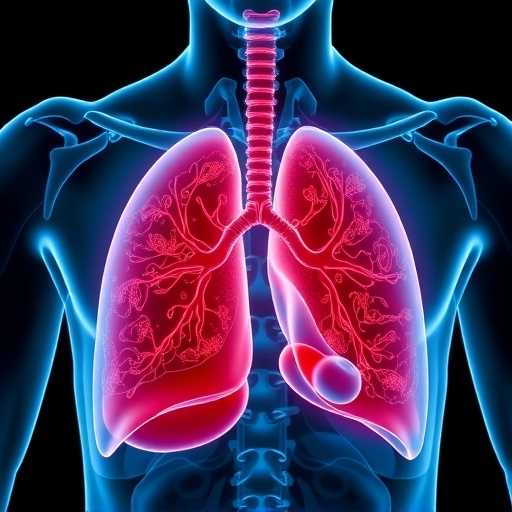In a pioneering advancement set to transform the landscape of pulmonary diagnostics and therapy, researchers from The University of Osaka have introduced an innovative procedure known as Balloon-Assisted Bronchoscope Delivery (BDBD). This groundbreaking technique is specifically engineered to access the deep, peripheral regions of the lungs where early-stage lung cancers often dwell—areas that have traditionally been difficult to reach with existing bronchoscopy methods. By employing a delicate, miniature balloon to dilate the intricate bronchial pathways, the method successfully transcends the physical limitations of conventional bronchoscopes. The implications of this innovation are vast, offering the potential not only for heightened diagnostic accuracy but also for minimally invasive therapeutic interventions.
Lung cancer remains one of the foremost causes of cancer-related deaths globally, largely due to challenges in early detection and diagnosis. Modern imaging techniques like computed tomography (CT) scans have improved the identification of suspicious nodules in the lung periphery, yet these findings often require confirmation through tissue biopsies for definitive diagnosis. However, the complex, narrowing airway structures toward the lung’s periphery have historically impeded bronchoscopic access to these suspicious sites, resulting in diagnostic uncertainty and limited options for treatment planning. Conventional bronchoscopes simply cannot navigate past the progressive tapering and branching of the bronchi, often forcing physicians to halt several centimeters away from target lesions.
To overcome this anatomical barrier, the research team at The University of Osaka devised a paradigm-shifting approach: rather than seeking progressively thinner endoscopes, they focused on physically expanding the bronchial pathways themselves. The BDBD technique involves the precise delivery of a slender catheter equipped with a small inflatable balloon to zones of bronchial constriction. Once positioned, this balloon is gently inflated, temporarily enlarging the airway diameter and creating a viable channel that allows the bronchoscope to be advanced further into the peripheral lung fields. This subtle yet effective airway dilation preserves the structural integrity of the bronchi while enabling deeper access.
The team’s first-in-human clinical trial has showcased the safety and efficacy of this novel technique. The results demonstrated that BDBD successfully navigates to lesions smaller than 20 millimeters—a size threshold that often corresponds with early-stage malignancies. This milestone is significant, as earlier and more precise tissue sampling can dramatically enhance diagnostic confidence, ultimately improving patient outcomes through timely and appropriately tailored interventions. Encouragingly, no adverse complications directly tied to the airway dilation procedure were observed, underscoring the technique’s potential for clinical adoption.
Beyond its immediate diagnostic benefits, BDBD heralds a new frontier in pulmonary medicine by setting the stage for future endoscopic therapies. The ability to traverse deep lung tissues more easily can facilitate minimally invasive delivery of targeted treatments such as localized drug administration, photodynamic therapy, or even bronchoscopic tumor ablation. These approaches promise to reduce the need for extensive surgical resections, which are often associated with significant morbidity. By minimizing invasiveness, patient recovery times can be shortened and quality of life preserved, marking a significant leap in thoracic oncology care paradigms.
The scientific foundation of BDBD is the result of a synergistic collaboration between academia and industry, reflecting the essence of translational research that bridges laboratory innovations to real-world clinical applications. As Professor Atsushi Kumanogoh, the lead investigator, succinctly puts it, “Our study has demonstrated the utility and safety of BDBD, enabling us to reach deep into the lungs where we couldn’t reach before. This will significantly expand early diagnostic and minimally invasive treatment options for lung cancer.” This sentiment not only highlights the clinical relevance of the technology but also its promise in reshaping standard pulmonology practices.
Technical nuances distinguish BDBD from prior bronchoscopic innovations. While previous efforts focused predominantly on engineering ultra-thin bronchoscopes—often compromising imaging quality and maneuverability—the balloon dilation approach preserves the use of standard bronchoscopic instruments augmented by the temporary expansion of the airway lumen. The balloon catheter’s design optimizes inflation diameter and compliance to ensure safe airway stretching without causing trauma. Real-time imaging guidance and precise pressure control systems are integrated to monitor the dilation process dynamically, preventing excessive strain on delicate lung tissues.
In practical terms, BDBD entails navigating a balloon catheter through the patient’s airways during bronchoscopy until the site of constriction is reached. The balloon is then inflated incrementally, carefully monitored via bronchoscopic visualization and fluoroscopy to confirm adequate dilation without airway injury. Following dilation, the bronchoscope advances beyond previous anatomical barriers to conduct high-precision biopsies or deliver therapeutic modalities. This technique leverages existing bronchoscopic infrastructure, promising ease of adoption in clinical settings without the need for entirely new equipment.
One of the most compelling aspects of BDBD is its minimal burden on patients relative to traditional surgical approaches. Surgical resection or transthoracic needle biopsies, while effective, come with higher risks including pneumothorax, bleeding, and extended hospital stays. In contrast, BDBD offers a streamlined, endoscopic route to difficult-to-access lesions, reducing procedural complexity and associated complications. This could democratize access to early lung cancer diagnostics, particularly in settings lacking advanced surgical capabilities.
The publication of the study in the esteemed journal Thorax underlines the scientific community’s recognition of BDBD’s potential impact. The findings emerge from a randomized controlled clinical trial involving human subjects, underscoring the robustness of the evidence supporting this technique. Through industry backing by Kaneka Corporation and state-of-the-art university research facilities, the development of BDBD exemplifies successful integration of engineering innovation and clinical medicine.
Looking ahead, the team envisions the evolution of BDBD from a biopsy-enabling procedure to a platform for an array of interventional pulmonary manipulations. Integration with AI-driven imaging analyses and robotic bronchoscopy systems could enhance precision and operational efficiency. Moreover, the principle of balloon-assisted dilation may find applications in other anatomical regions where access is limited due to physiological constrictions, opening new avenues in minimally invasive diagnostics and therapeutics.
In conclusion, Balloon-Assisted Bronchoscope Delivery represents a monumental leap forward in the field of pulmonary medicine. By harnessing a simple yet ingenious mechanical strategy to widen the bronchial airways temporarily, researchers at The University of Osaka have not only expanded the horizons of lung cancer diagnosis but also laid the groundwork for transformative, minimally invasive treatments. This breakthrough underscores a shift towards patient-centered innovation—prioritizing safety, precision, and reduced invasiveness—and holds the promise of saving countless lives through earlier detection and more targeted cancer care.
Subject of Research: People
Article Title: Balloon dilatation for bronchoscope delivery: First-in-human trial of a novel technique for peripheral lung field access
News Publication Date: 17-Nov-2025
References: DOI: 10.1136/thorax-2025-223218
Image Credits: Kotaro Miyake
Keywords: Health and medicine, Cancer, Lung cancer, Medical diagnosis, Medical treatments, Medical technology
Tags: advanced bronchoscopy methodsBalloon-Assisted Bronchoscope Deliverybronchial pathway dilationchallenges in lung cancer diagnosisdeep lung tumor access techniqueearly-stage lung cancer detectioninnovative pulmonary diagnosticslung cancer mortality reductionminimally invasive lung cancer therapyperipheral lung imaging advancementspioneering medical research breakthroughstissue biopsy confirmation





